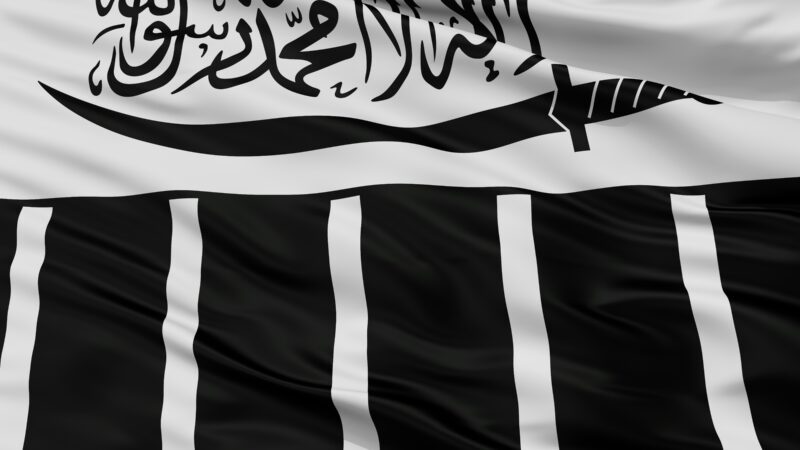Abstract: Contrary to lay misconceptions about its ‘regionality’, this paper uses primary and secondary sources to show that Lashkar-e-Taiba has always had a global agenda that would inevitably lead to international operations—despite its initial focus on Kashmir. Importantly, this agenda is rooted in Hafiz Saeed’s Salafist ideology, including a history that includes international jihadist influences like Abdullah Azzam and Osama bin Laden. Lashkar-e-Taiba’s expansionist plans manifested as international operations are further underpinned by transnational funding sources and connections. Thus, it is a violent extremist group with Salafist globalism in its roots, which has led to its operational internationalisation.
Problem statement: How to make sense of Lashkar-e-Taiba’s international operations in the 21st century? Are they inevitable because of the nature of the organisation’s foundations?
So what?: World leaders must address the serious threat posed by Lashkar-e-Taiba by eliminating the root causes of geopolitical disputes that fuel the group. This Salafist entity must also be rendered irrelevant by reformist Islamic scholars reforming the Shariah on whose problematic parts Lashkar’s ideology is based.

No “Army of the Pure”
Most studies on Lashkar-e-Taiba (LeT) fail to grasp the meaning behind its name, which betrays its founding principle that has culminated in transnational acts of terrorism. The name of this Pakistani Salafist jihadist organisation is commonly mistranslated as the ‘Army of the Pure’.[1] The correct translation, instead, is the ‘Army of Madinah’, since ‘Taiba’ is an appellation of the Islamic holy city of Madinah.[2]
This meaning of LeT’s name is essential to understanding its ideology and objectives: it considers itself the universal defending force of ‘Madinah’, or, in other words, of Islam and the global Muslim community. Accordingly, LeT believes in striking whomever it perceives is threatening Islam and Muslims anywhere in the world, particularly the so-called ‘Hindu-Zionist-Crusader alliance’.[3] Contrarily, an incorrect understanding of the group’s name helps create the lay misconception that it is ‘regionally focussed’.
LeT believes in striking whomever it perceives is threatening Islam and Muslims anywhere in the world, particularly the so-called ‘Hindu-Zionist-Crusader alliance’.
LeT’s has taken a fascinating trajectory of internationalisation based on its roots. Since its inception, it has espoused a global jihadistideology, secured international funding sources, and forged transnational networks. Although LeT’s key tactical focus, that is, Kashmir, has been local, it has only acted as part of a grand global plan to expand practically into an international invading army.
This plan is indeed in line with its original ideology drawn from the histories of LeT and Professor Hafiz Muhammad Saeed, the emir of Jamaat-ud-Dawah (JuD) [Society for Preaching], whose militant wing LeT is.[4] Besides, the roles of transnational financial and organisational connections also remain important. Such linkages serve to impact the ideological and operational direction of the group. Unsurprisingly, the organisation’s operations have inevitably evolved from local to international.
LeT’s Early Ideological Influences
Pakistani journalist Arif Jamal has carried out extensive research on LeT and also authored a comprehensive book on the subject, Call for Transnational Jihad: Lashkar-e-Taiba 1985–2014.[5] According to Jamal, LeT emerged from Markaz Dawah-wal-Irshad(MDI), translated as the ‘Centre for Religious Learning and Propagation’, originally established by the remnants of the ikhwan [brothers].
The extremist ikhwan had rebelled against the Saudi regime for allegedly being ‘corrupt’, ‘pro-West’, and even ‘infidel’, occupying the Kaaba in Makkah as a protest in 1979. Later, members of the group spread to various countries and established cells, particularly arriving in Afghanistan for the anti-Soviet war in 1980.[6]
It was in the 1980s that Abdullah Azzam, the Palestinian transnational jihadist most active during the anti-Soviet war in 1979–89, met Saeed and Zafar Iqbal. They were university professors of Islamic Studies in Lahore,[7] leading a small Ahl-e-Hadith missionary group.[8] In 1986, this group was merged into Zaki-ur-Rahman Lakhvi’s anti-Soviet militant outfit for tactical reasons.
This merger resulted in MDI, with Azzam as one of 17 co-founders that included the ikhwan members, with the purpose of ‘organis[ing] the Pakistanis participating in Afghan Jihad on one platform’.[9] Keeping this in view, LeT originated in 1990 as MDI’s armed wing. Azzam also co-founded MDI’s Muridke Markaz [headquarters] in Pakistani Punjab, where ideological training of recruits continues,[10] with Azzam’s speeches and writings serving as jihadist textbooks.[11] Evidently, LeT inherited the Salafist doctrine from the founding members of the international MDI.[12]
As LeT adheres to the Ahl-e-Hadith school of thought,[13] which is the South Asian version of Salafism, it engages in an essentially ‘politicised reading of religion’.[14] This Islamist approach was espoused by Azzam himself—who also happened to be Osama bin Laden’s ‘first mentor’[15] and the crucial link between the latter and the MDI’s Markaz.[16] Therefore, LeT, as the militant wing of the ex-MDI (renamed JuD in December 2001), inevitably carries his international influence. Azzam once claimed before an American Muslim audience: ‘Whenever jihad is mentioned in the Holy Book [Qura’n], it means the obligation to fight. It does not mean to fight with the pen…’[17]
‘Whenever jihad is mentioned in the Holy Book [Qura’n], it means the obligation to fight. It does not mean to fight with the pen…’
Advocating similar perpetual fighting, Saeed in 2007—just a year before the 12 coordinated shooting and bombing attacks across the Indian metropolis of Mumbai—declared in his congregational Qadsia masjid (that also serves as JuD’s headquarters) in Lahore: ‘Jihad in Kashmir will reach its logical end when all the Hindus in India are terminated. Jihad is a diktat by God, not an order by any army general that could be started one day and halted the next day upon his orders.’[18] Paradoxically, in a social media interview in 2017, Saeed appeared friendly and even humanitarian towards Hindus, opposing the targetting of any Hindu civilian, even inside India.[19]
Although Kashmir as mentioned above by Saeed is a local focus of LeT, it is in accordance with its international ideology. The practical manifestation of this ideology has grown more globalised over time, as in the Mumbai siege in 2008—the ‘second deadliest terrorist attack since 9/11’[20]—that killed citizens of 15 countries, including India, while also particularly targetting a Jewish outreach centre.
International Jihadist Influences as Inspiration Sources
Following Azzam’s vision, LeT believes in attacking the ‘middle enemy’, that is, predominantly non-Muslim states such as India that, in its view, are oppressing Muslim populations.[21] The group draws inspiration from a questionable Hadith—again an international source—regarding ‘Ghazwa-e-Hind’, meaning the ‘Indian Holy War’, which ‘predicted the eventual victory of mujahideen in a future battle in India’.[22]
However, LeT’s transnational dimension is also visible in its attempts to attack the Western ‘far enemy’, a term borrowed from Osama bin Laden.[23] An example is a predominantly non-Muslim state like Denmark that LeT sees as attacking Islam by permitting the publication of objectionable cartoons, avenging which it considers its duty—given its self-proclaimed association with Madinah.
Regarding such middle and far enemies, LeT’s emir in Jammu and Kashmir, Abdur Rahman Aldakhil, claimed, ‘Qur’an orders us to hit each and every knuckle of them [sic] and instructs us to treat them in the same way as they treat us.’[24] A popular slogan by LeT, which makes no distinction among non-Muslim ‘enemies’, reads: ‘Break the necks and joints of non-Muslims.’[25]
Notwithstanding the violence against civilians, LeT, as an Ahl-e-Hadith organisation, sees dawah [inviting towards ‘Islam’] and jihad as equally important to bringing reform in society. This also happens to be the influential Egyptian Salafist ideologue Sayyid Qutb’s formula for revolution. According to Saeed, ‘Islam propounds both dawah and jihad. Both are equally important and inseparable… This is the only way to bring about change among [sic] individuals, society and the world.’[26]
Dawah is an important underpinning of LeT’s international Salafist philosophy since it considers proselytisation through JuD a prerequisite before someone can join its ranks. Otherwise, the ‘corrupt’ Muslims are called mushrikun or polytheists, unfit to become transnational or even local jihadists.[27] Paradoxically, Saeed’s JuD has published multiple books against takfir (calling a Muslim an infidel), which he showed in an interview.[28]
Nevertheless, for LeT’s expansionist goals to be achieved, it must receive a supply of ‘purified’ fighters who have been through dawah first. Whilst expanding into international regions such as Bosnia and Herzegovina and the Philippines, it glorified unrealistically such purged jihadists in its magazine Mujala-tu-Dawah through poetry such as, ‘When the mujahid would return from Washington with a sack full of “spirit”!’[29] Such a line of thought echoes Qutb’s recommended method for precipitating an ‘Islamic Revolution’, first through non-violent training and then violent action.
For LeT’s expansionist goals to be achieved, it must receive a supply of ‘purified’ fighters who have been through dawah first. Whilst expanding into international regions such as Bosnia and Herzegovina and the Philippines, it glorified unrealistically such purged jihadists in its magazine Mujala-tu-Dawah through poetry.
Saeed’s Personal and Academic Background
By virtue of his family background, Saeed—the former emir of LeT who still lectures on jihadism—inherited hatred for Hindus in particular and non-Muslims in general (which he does not accept publicly). This is because 36 members of his extended family were killed during the 1947 Partition riots.[30] He grew up in Pakistani Punjab and studied at the University of Punjab, Lahore, serving as a student leader in Syed Abul A’la Maududi’s Jamaat-i-Islami’s student wing, Islami Jamiat-e-Tulaba [Islamic Coalition of Students]. Saeed obtained two master’s degrees in Islamic Studies and Arabic. He subsequently worked as a research scholar at the Council of Islamic Ideology—a key instrument of President General Zia-ul-Haq’s ‘Islamisation’—working on the controversial Hudud Ordinance Bill.[31] Afterwards, Saeed was employed as a university lecturer.
Importantly thereafter, he flew to King Saud University in Riyadh, Saudi Arabia, studying further under the radical Saudi Grand Mufti known as Sheikh bin Baaz. The latter became the first cleric to issue a fatwa [decree] enjoining Muslims worldwide to join the Islamist struggle in Afghanistan against the Soviets and their Afghan allies.[32] According to Saeed himself, he listened to the mujahideen commander Abdul Rab Rasul Sayyaf’s speech at the masjid under bin Baaz in Riyadh. Sayyaf (with whom Saeed also trained later after arriving in Afghanistan) narrated the situation in Afghanistan there.[33]
Moreover, bin Baaz taught him the Hadith and inspired him to undertake missionary work in the form of JuD. According to Saeed, bin Baaz himself was involved in transnational proselytisation through the extensive publication of literature from Saudi Arabia.[34] As Saeed said, ‘Whatever we are doing, most of it I have learnt from Saudi theologians.’[35] He still considers bin Baaz his spiritual mentor and credits him for his global Salafist ideology of waging private, armed jihadism, which Saeed has perpetuated locally and internationally through LeT. These later developments in Saeed’s life trajectory depict several international underpinnings of LeT.
Transnational Sources of Funding
As LeT has traditionally worked towards the secession of Kashmir from India, its Kashmir operations have been fully funded by state actors within Pakistan.[36] However, for its transnational operations, it has more diverse financial sources, including independent fundraising to support its charitable activities. These sources additionally include money generated from animal hides after the Islamic Eid-ul-Adha festival, as well as donations from LeT’s regular members and Ahl-e-Hadith traders.
Internationally, wealthy Sheikhs from Gulf countries and Pakistani expatriates sympathetic to the Salafist creed are the organisation’s donors.[37] Moreover, before its inception, LeT’s co-founder Zaki-ur-Rahman Lakhvi’s Saudi brother-in-law, a long-time friend of Osama bin Laden, donated 10 million Pakistani rupees for Muridke’s sprawling JuD complex, which later became LeT’s birthplace.[38] This is bound to impact the group’s functioning along with the affluent Salafist Arabs’ continuing donations. These finances serve as an effective underpinning for LeT, helping to determine its direction just as international funding impacts any recipient organisation.
Internationally, wealthy Sheikhs from Gulf countries and Pakistani expatriates sympathetic to the Salafist creed are the organisation’s donors.
Regional and Transnational Links
Concerning LeT’s connections with other groups, it has been engaged briefly in sectarian warfare inside Pakistan along with other anti-Shia organisations. However, it had to abandon sectarianism as it became more engrossed with the national Kashmir project.[39] LeT’s connections with al-Qaeda are well known, and Saeed was in regular phone contact with Osama bin Laden whilst the latter was in Pakistan.[40] This is further evidence of LeT’s global underpinnings. Besides, the group cooperated with the Taliban during the American invasion of Afghanistan post-9/11,[41] fought alongside militant allies in Iraq, and established cells in Europe as well as the United States.[42]
Inside India, LeT has incited the Student Islamic Movement of India (SIMI) to declare that ‘Islam is our nation, not India.’[43] It has also cooperated with transnational criminal networks like the D-Company, led by India’s most wanted criminal, Dawood Ibrahim, who is sought for a series of bombings in Mumbai in 1993. His smuggling and heroine trades have all been used in support of LeT for its financing and trafficking operatives to and from India.[44] Indeed, the group runs a well-established network for conducting terrorist activities in several countries. As Jamal highlighted, it has a presence in 50 countries.
Internationalisation of Operations
It is evident that the organisation is not entirely under Pakistan’s control, and is increasingly pursuing an independent, international jihadist agenda. This is rather apart from the more limited agenda of the nationalist Inter-Services Intelligence (ISI).[45]
For instance, LeT considers the recapture of formerly Muslim-ruled territories, such as Spain, its religious duty, by undertaking jihadism—obligatory for all Muslims in its Salafist doctrine.[46] As Jamal pointed out in a discussion of his LeT book, the group believes in the conquest of the erstwhile Roman Empire and even the United States of America. It claims that some Muslims arrived in the United States to conquer it 400–500 years ago, with no success. Therefore, it is now LeT’s responsibility to complete this unaccomplished mission.
LeT believes in the conquest of the erstwhile Roman Empire and even the United States of America.
Additionally, the practical internationalisation of its targets is also visible in its terrorist plots. LeT planned to attack the office of the newspaper Jyllands-Posten, which in 2005–06 published Islamically offensive cartoons in Denmark, and a synagogue in the country. For this purpose, it hired David Headley, an American citizen, who had already ‘spent several years reconnoitring for the November 2008 assault on Mumbai’ in which foreign citizens were also targeted.[47] In another international plot, LeT employed a French citizen, Willie Brigitte, to scout potential targets in Australia in 2003.[48] Moreover, it also planned to attack an Atlantic Airlines aeroplane during flight.[49]
Given its international underpinnings, internationalisation or evolution is a constant theme about LeT. Hence, its attacking tactics have also evolved from the pioneering of beheadings and massacring of Kashmir’s Hindu population to fedayeen missions emanating originally from the Middle East.[50] LeT first undertook these after an unfavourable outcome of the 1999 Kargil War.[51] Since then, the fedayeen squads have been modified from being only one two-man team to multiple teams, as in Mumbai, there were five two-man fedayeen squads to attack in five different places simultaneously.[52]
Hafiz Abdur Rahman Makki, Saeed’s cousin and LeT’s co-founder, ‘legitimised’ the daredevil fedayeen attacks that require plunging into the enemy, likely resulting in death, as not being suicide, which is forbidden in Islam. He noted, ‘No fedayee ever killed himself’, and ‘The fedayee would like to be killed by an infidel or unbeliever’.[53]
Salafist Globalist Underpinnings
LeT is a transnational jihadist organisation with a rich Salafist history that not only has a presence in several parts of the world but also has the necessary financial and organisational networks to support itself. It survives on the rigid ideology it preaches through its dawah, inside and outside its Muridke Markaz. With such underpinnings, LeT unsurprisingly has an expansionist agenda that culminates only in a ‘caliphate’ to be run according to its puritanical moral rules.
LeT is a transnational jihadist organisation with a rich Salafist history that not only has a presence in several parts of the world but also has the necessary financial and organisational networks to support itself.
Understandably, LeT’s initial local focus on Kashmir and the anti-Soviet war in Afghanistan gradually advanced into a more international set of targets. Likewise, the means of achieving these targets have also evolved over time. Lay perceptions of LeT entail mistaking the organisation as some ‘regional’ jihadist organisation with indigenous roots. On the contrary, its Salafist globalist underpinnings inevitably result in an international operational focus that remains unmistakable. Considering LeT’s longstanding presence and linkages in Afghanistan, this transnational threat can only metastasise under the Taliban post-2021.
Naveen Khan is a Nonresident Research Fellow with the Centre for Intelligence and Security Studies at the University of Akron, Ohio, USA, holding an MSc in Sociology from the London School of Economics (LSE). Her research interests include South and Central Asian violent/non-violent Islamist organisations, misogyny and terrorism, and Pashtun nationalism. She has published in The Diplomat, Geopolitical Monitor, and the Johns Hopkins University’s School of Advanced International Studies (SAIS) Review of International Affairs. The views contained in this article are the author’s alone and do not represent the views of the University of Akron.
[1] V. S. Subrahmanian, Aaron Mannes, Amy Silva, Jana Shakarian, John P. Dickerson, Lashkar-e-Taiba: Computational Analysis, (New York: Springer, 2013), 24.
[2] Stephen Tankel, Storming the World Stage: The Story of Lashkar-e-Taiba, (London: Hurst and Company, 2011), 69.
[3] Ibid, 1.
[4] Mujahid Hussain, Punjabi Taliban: Driving Extremism in Pakistan, (New Delhi: Pentagon Security International, 2012), 12.
[5] Arif Jamal, Call for Transnational Jihad: Lashkar-e-Taiba 1985–2014, (New Jersey: AvantGarde Books LLC, 2014).
[6] YouTube video, ‘The Rise of Lashkar-e-Taiba’, New America, https://www.youtube.com/watch?v=g2XbKGMuDhQ> (Accessed December 03, 2023).
[7] V. S. Subrahmanian, Aaron Mannes, Amy Silva, Jana Shakarian, John P. Dickerson, Lashkar-e-Taiba: Computational Analysis, (New York: Springer, 2013), 29.
[8] Stephen Tankel, Lashkar-e-Taiba: Past Operations and Future Prospects, (Washington DC: New America, 2011), 2.
[9] E. Kohlmann, Regina v. Mohammed Ajmal Khan, Palvinder Singh, and Frzana Khan, 2000, http://web.archive.org/web/20000311154008/http://www.dawacenter.com/introduction/introduction.html (Accessed December 03, 2023).
[10] Mujahid Hussain, Punjabi Taliban: Driving Extremism in Pakistan, (New Delhi: Pentagon Security International, 2012), 105.
[11] Wilson John, Lashkar-e-Toiba: New Threats Posed by an Old Organization, (Washington DC: Jamestown Foundation, 2005), https://jamestown.org/program/lashkar-e-toiba-new-threats-posed-by-an-old-organization/ (Accessed April 29, 2024).
[12] Arif Jamal, Call for Transnational Jihad: Lashkar-e-Taiba 1985–2014, (New Jersey: AvantGarde Books LLC, 2014).
[13] Ahl-e-Hadith is a sect within Sunni Islam that rejects the other four Sunni schools of Islamic jurisprudence on the basis of accepting the Qur’an, Sunnah [Prophetic ways] and Hadith [Prophetic sayings] as the only sources of the shariah [Islamic law].
[14] Humeira Iqtidar, Secularising Islamists? Jama’at-e-Islami and Jama’at-ud-Da’wa in Urban Pakistan, (Chicago and London: The University of Chicago Press, 2011), 111.
[15] Stephen Tankel, Lashkar-e-Taiba: Past Operations and Future Prospects, (Washington DC: New America, 2011), 3.
[16] Wilson John, Lashkar-e-Toiba: New Threats Posed by an Old Organization, (Washington DC: Jamestown Foundation, 2005), https://jamestown.org/program/lashkar-e-toiba-new-threats-posed-by-an-old-organization/ (Accessed April 29, 2024).
[17] Investigative Project on Terrorism (IPT), Abdullah Azzam Profile, 2008, http://investigativeproject.org/profile/103 (Accessed December 03, 2023).
[18] Mujahid Hussain, Punjabi Taliban: Driving Extremism in Pakistan, (New Delhi: Pentagon Security International, 2012), 113.
[19] Dailymotion video, ‘Is Hafiz Saeed a Terrorist? Hamza Ali Abbasi’s Exclusive Interview’, Video Station, https://www.dailymotion.com/video/x5az5cd (Accessed December 03, 2023).
[20] Eric Dill, Lashkar-e-Taiba: A Global Threat Today, A Threat to Pakistan Tomorrow, (Virginia: Marine Corps University, 2012), ii.
[21] V. S. Subrahmanian, Aaron Mannes, Amy Silva, Jana Shakarian, John P. Dickerson, Lashkar-e-Taiba: Computational Analysis, (New York: Springer, 2013), 32.
[22] Mujahid Hussain, Punjabi Taliban: Driving Extremism in Pakistan, (New Delhi: Pentagon Security International, 2012), 100.
[23] Idem.
[24] Murder of Iranian Consulate Sadiq Ganji in Lahore, published Daily Dawn, Lahore, 19December, 1990, in ibid, 109.
[25] Ayesha Siddiqa, a London-based Pakistani security analyst, has created a photo library of various LeT graffiti, in Tankel, 2011, 85.
[26] ‘Interview with Hafiz Saeed’, Takbeer, 12 August 1999, 143, found in Saeed Shafqat, From Official Islam to Islamism: The Rise of Daawa-ul-Irshad and Lashkar-e-Taiba, in Pakistan: Nationalism Without a Nation?, 141.
[27] Stephen Tankel, Lashkar-e-Taiba: Past Operations and Future Prospects, (Washington DC: New America, 2011), 30.
[28] Dailymotion video, ‘Is Hafiz Saeed a Terrorist? Hamza Ali Abbasi’s Exclusive Interview’, Video Station.
[29] Mujahid Hussain, Punjabi Taliban: Driving Extremism in Pakistan, (New Delhi: Pentagon Security International, 2012), 13.
[30] Stephen Tankel, Lashkar-e-Taiba: Past Operations and Future Prospects, (Washington DC: New America, 2011), 13.
[31] YouTube video, ‘Aik Din Geo Kay Sath with Hafiz Saaed of JuD’, Aik Din Geo Kay Sath, https://www.youtube.com/watch?v=eShV-aACNh8> (Accessed December 03, 2023).
[32] V. S. Subrahmanian, Aaron Mannes, Amy Silva, Jana Shakarian, John P. Dickerson, Lashkar-e-Taiba: Computational Analysis, (New York: Springer, 2013), 30.
[33] YouTube video, ‘Aik Din Geo Kay Sath with Hafiz Saaed of JuD’, Aik Din Geo Kay Sath.
[34] Idem.
[35] Idem.
[36] Mujahid Hussain, Punjabi Taliban: Driving Extremism in Pakistan, (New Delhi: Pentagon Security International, 2012), 101.
[37] Ibid, 109.
[38] Tankel, 2012, 70.
[39] Mujahid Hussain, Punjabi Taliban: Driving Extremism in Pakistan, (New Delhi: Pentagon Security International, 2012), 99.
[40] V. S. Subrahmanian, Aaron Mannes, Amy Silva, Jana Shakarian, John P. Dickerson, Lashkar-e-Taiba: Computational Analysis, (New York: Springer, 2013), 53.
[41] Stephen Tankel, Lashkar-e-Taiba: Past Operations and Future Prospects, (Washington DC: New America, 2011), 53.
[42] Eric Dill, Lashkar-e-Taiba: A Global Threat Today, A Threat to Pakistan Tomorrow, (Virginia: Marine Corps University, 2012), ii.
[43] P. Swami, Pakistan and the Lashkar’s Jihad in India, The Hindu, December 09 2008.
[44] G. King, The Most Dangerous Man in the World: Dawood Ibrahim, New York: Chamberlain Bros, 2004.
[45] Ibid, 4.
[46] YouTube video, ‘The Rise of Lashkar-e-Taiba’, New America.
[47] Sebastian Rotella, The American Behind India’s 9/11 and How the US Botched Chances to Stop Him, 2011, www.propublica.org/article/david-headley-homegrown-terrorist (Accessed December 03, 2023).
[48] Ibid, 168.
[49] YouTube video, ‘The Rise of Lashkar-e-Taiba’, New America.
[50] Center for Security Studies (CSS)—ETH Zurich, Lashkar-e-Taiba: Local Organisation, Global Ambitions, CSS Analysis in Security Policy, Vol. 132 (2013), 1-4, 2.
[51] V. S. Subrahmanian, Aaron Mannes, Amy Silva, Jana Shakarian, John P. Dickerson, Lashkar-e-Taiba: Computational Analysis, (New York: Springer, 2013), 47.
[52] Ibid, 55.
[53] Abdur Rahman Makki, Fedayee Activities in Sharia: Part III, Voice of Islam, June 2001, in Tankel, 2011, 64.






